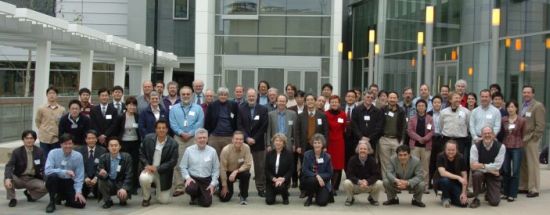Calit2 and OptIPuter Host 5th Annual ON*VECTOR Photonics Workshop
San Diego, CA, March 3, 2006 -- The 5th Annual ON*VECTOR International Photonics Workshop was hosted by Calit2 at UCSD in conjunction with the OptIPuter project. The three-day meeting, which ended March 1, was sponsored by NTT Network Innovation Laboratories of Japan.
ON*VECTOR, the Optical Networked Virtual Environments Collaborative Trans-Oceanic Research, is a joint project of NTT Network Innovation Laboratories, University of Tokyo's Aoyama/Morikawa Laboratory, University of Illinois at Chicago (UIC) Electronic Visualization Laboratory (EVL), and the UCSD Division of Calit2. It is managed by Pacific Interface Inc. (PII).
|
Presentations at the workshop focused on the applications, technology and policy related to photonic networks. A photonic (or optical) network is a communication network in which information is transmitted in the form of light waves (photons). Optical networks provide greatly increased bandwidth because multiple signals can be transmitted through optical fiber across individual wavelengths of light, called lambdas .
"The workshop was a very useful intersection of network infrastructure managers and key engineers, and application researchers, who rarely have opportunities to talk to each other," said Bill St.Arnaud, senior director of Network Projects, CANARIE Inc. "It is quite clear that in the near future we are going to have an abundance of optical networks. ON*VECTOR and Calit2 are among the few organizations that are radically thinking about what all this optical connectivity is going to mean in terms of new applications and how we even use communication networks. I believe that developments in optical networking technologies will fundamentally change the way we think about and use networks -- and for the first time allow us truly to decouple the application from the computer."
"One of the early adopters of this new way of thinking will be e-Science and collaborative research," continues St. Arnaud. These applications are very data intensive, and require dedicated optical paths; unfortunately, at major events like iGrid 2005 and SC|05, these links need to be shared. Juggling researchers' needs and desires with what is available at any given time is a delicate balancing act. Maxine Brown, UIC/EVL associate director, spoke on "Collaborating with Lambdas." When scheduling bandwidth, many parameters must be taken into account, including: mapping bandwidth requirements to what is available, accommodating global time zones and conference schedules, keeping carriers and global network operation centers (NOCs) aware of events, and dealing with potential problems that can arise (e.g., equipment failure, unscheduled network maintenance, operator unavailability, natural disasters, etc.).
"Outreach efforts are beginning to identify and educate the users and applications of this technology," said Brown, who is also project manager on the OptIPuter project. "Collaborations will be formed over time zones, languages, funding models, policies and cultures." Access issues can be eliminated by the establishment of campus lambda networks that connect researchers' laboratories end-to-end. Added CANARIE's St. Arnaud: "It is not far-fetched to imagine 10Gb-40Gb wavelengths going directly to a university researcher's desktop in the not-too-distant future."
"NTT and the organizing committee assembled a program of outstanding breadth and depth. I especially valued the opportunity to hear about the forward-looking initiatives underway in Japan, the Pacific Rim, and at a global scale," said Franco Travostino, director of Advanced Technology at Nortel Networks. "I walked away with the confidence that there is a fully functional ecosystem in place, with symbiotic innovation in the network infrastructure, the applications, and the steps that bring international communities together."
Calit2 director Larry Smarr and several researchers affiliated with the institute spoke at the workshop. Smarr briefed attendees on a joint project with the J. Craig Venter Institute to develop and deploy cyberinfrastructure to support research in marine microbial genomics. San Diego Supercomputer Center scientist and OptIPuter co-PI Phil Papadopoulos talked about the NSF-funded project, which is a partnership led by UCSD and UIC. Calit2 E-Sciences Program Manager Matthew Arrott delivered a presentation titled "20,000 Gigabits Under the Sea," about a Calit2/University of Washington partnership called the Laboratory for Ocean Observatory Knowledge Integration Grid (LOOKING). Peter Arzberger, UCSD professor affiliated with Calit2 and director of the Life Sciences Initiatives, talked about the Pacific Rim Applications and Grid Middleware Assembly (PRAGMA), a leading multinational research effort. And Tom DeFanti, codirector of UIC/EVL and a principal scientist in Calit2 at UCSD, moderated the panel discussion on LambdaGrids.
Members of the ON*VECTOR program committee included Tomonori Aoyama (University of Tokyo), Maxine Brown (UIC/EVL), Tom DeFanti (UIC, Calit2 at UCSD), Laurin Herr (PII), Larry Smarr (Calit2) and Natalie Van Osdol (PII).

